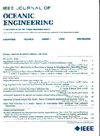多波束测深水柱数据伪影的模拟与去除方法
IF 5.3
2区 工程技术
Q1 ENGINEERING, CIVIL
引用次数: 0
摘要
现代多波束测深仪收集水深测深、海底后向散射强度和水柱后向散射值。水柱数据可用于识别海底以上的特征或生物,具有广泛的应用。该数据分析的一个关键限制是由于换能器设计和接收机阵列副瓣诱导信号干扰而存在固有的系统伪影模式。在本文中,描述了一种基于“参考ping”模拟和删除这些工件的方法,“参考ping”是使用清水数据子集创建的,它捕获原始数据集中存在的固有工件。在对每个ping的范围和海底振幅值进行调整后,该参考ping用于模拟ping特定的伪迹模式(“模拟ping”),这些伪迹模式可以从原始数据中去除,以改善水柱内的目标识别。该方法应用于五种不同的Kongsberg Discovery多波束测深系统,涵盖了一系列的工作特性。将模拟ping信号与所有系统采集的清水数据进行比较,结果显示R2相关性大于0.9,突出了该方法再现常用多波束回声测深仪中普遍存在的固有系统伪影的有效性。模拟ping与原始数据之间的均方根误差用于证明该方法在去除伪像方面的有效性,所有系统的值均<0.04。较大的数值也用于确定水柱中潜在的感兴趣的特征。该方法为改进水柱分析提供了有希望的基础,无论是作为单独的方法还是与其他现有的处理方法相结合。本文章由计算机程序翻译,如有差异,请以英文原文为准。
A Method for the Simulation and Removal of Multibeam Echosounder Water Column Data Artifacts
Modern multibeam echosounders collect bathymetric soundings, seafloor backscatter intensities, and water column backscatter values. The water column data can be used to identify features or biology above the seafloor with a broad range of applications. A key limitation for the analysis of this data is the presence of intrinsic system artifact patterns due to transducer design and receiver-array sidelobe-induced signal interferences. In this article, a method is described for simulating and removing these artifacts based on a “reference ping,” created using a subset of clear water data, which captures intrinsic artifacts present in the original data set. This reference ping, after adjusting for the range and seafloor amplitude values of each ping, is used to simulate ping-specific artifact patterns (“simulated ping”), which can be removed from the original data for improving target identification within the water column. This method was applied to five different Kongsberg Discovery multibeam echosounder systems covering a range of operational characteristics. Comparison of simulated pings with clear water data acquired by all systems shows greater than 0.9 R2 correlation, highlighting the efficacy of the method to reproduce intrinsic system artifacts prevalent in commonly used multibeam echosounders. The root-mean-squared error between simulated pings and original data was used to demonstrate the method's effectiveness in removing artifacts, with values of <0.04 for all systems. Large values were also used to identify potential features of interest within the water column. This method provides a promising foundation for improved water column analysis, either as a stand-alone method or combined with other current processing methods.
求助全文
通过发布文献求助,成功后即可免费获取论文全文。
去求助
来源期刊

IEEE Journal of Oceanic Engineering
工程技术-工程:大洋
CiteScore
9.60
自引率
12.20%
发文量
86
审稿时长
12 months
期刊介绍:
The IEEE Journal of Oceanic Engineering (ISSN 0364-9059) is the online-only quarterly publication of the IEEE Oceanic Engineering Society (IEEE OES). The scope of the Journal is the field of interest of the IEEE OES, which encompasses all aspects of science, engineering, and technology that address research, development, and operations pertaining to all bodies of water. This includes the creation of new capabilities and technologies from concept design through prototypes, testing, and operational systems to sense, explore, understand, develop, use, and responsibly manage natural resources.
 求助内容:
求助内容: 应助结果提醒方式:
应助结果提醒方式:


